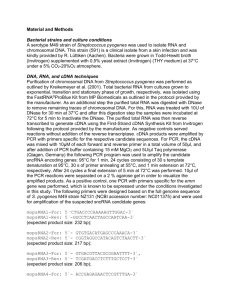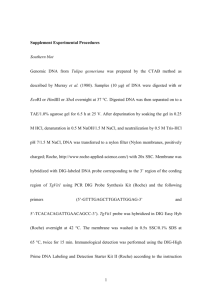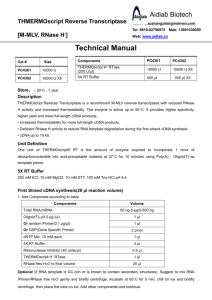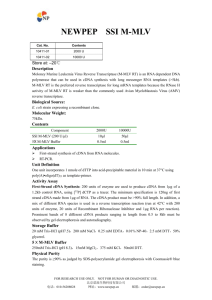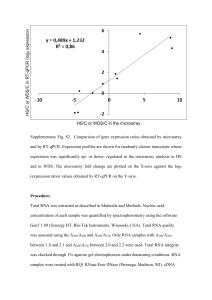Quantitative RT-PCR
advertisement
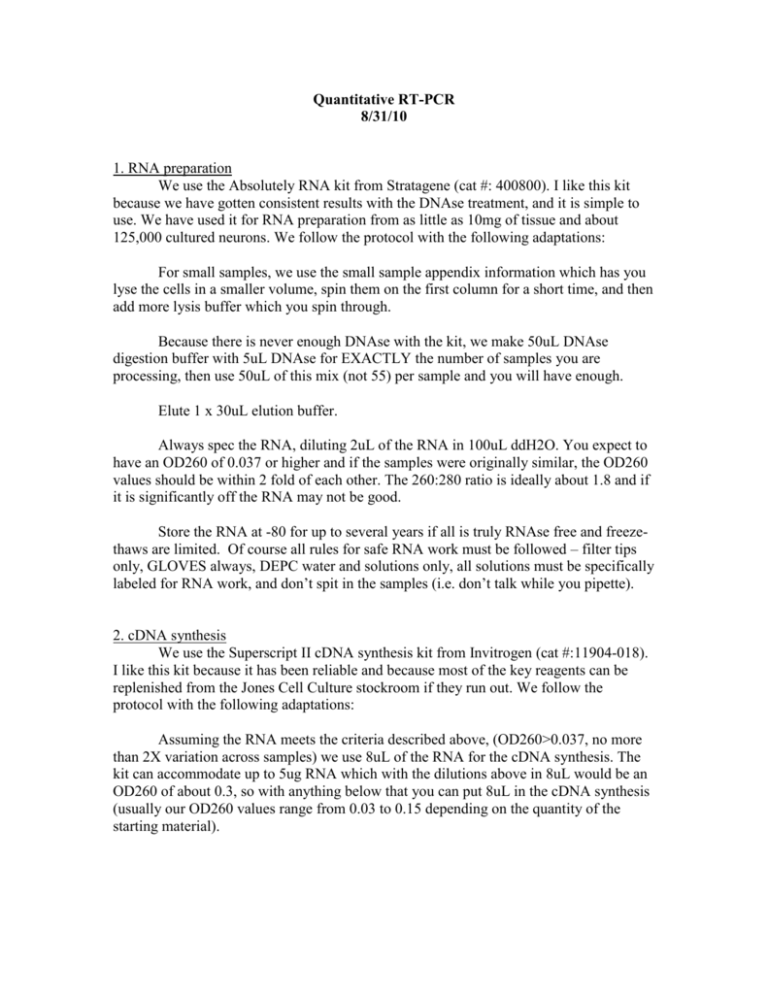
Quantitative RT-PCR 8/31/10 1. RNA preparation We use the Absolutely RNA kit from Stratagene (cat #: 400800). I like this kit because we have gotten consistent results with the DNAse treatment, and it is simple to use. We have used it for RNA preparation from as little as 10mg of tissue and about 125,000 cultured neurons. We follow the protocol with the following adaptations: For small samples, we use the small sample appendix information which has you lyse the cells in a smaller volume, spin them on the first column for a short time, and then add more lysis buffer which you spin through. Because there is never enough DNAse with the kit, we make 50uL DNAse digestion buffer with 5uL DNAse for EXACTLY the number of samples you are processing, then use 50uL of this mix (not 55) per sample and you will have enough. Elute 1 x 30uL elution buffer. Always spec the RNA, diluting 2uL of the RNA in 100uL ddH2O. You expect to have an OD260 of 0.037 or higher and if the samples were originally similar, the OD260 values should be within 2 fold of each other. The 260:280 ratio is ideally about 1.8 and if it is significantly off the RNA may not be good. Store the RNA at -80 for up to several years if all is truly RNAse free and freezethaws are limited. Of course all rules for safe RNA work must be followed – filter tips only, GLOVES always, DEPC water and solutions only, all solutions must be specifically labeled for RNA work, and don’t spit in the samples (i.e. don’t talk while you pipette). 2. cDNA synthesis We use the Superscript II cDNA synthesis kit from Invitrogen (cat #:11904-018). I like this kit because it has been reliable and because most of the key reagents can be replenished from the Jones Cell Culture stockroom if they run out. We follow the protocol with the following adaptations: Assuming the RNA meets the criteria described above, (OD260>0.037, no more than 2X variation across samples) we use 8uL of the RNA for the cDNA synthesis. The kit can accommodate up to 5ug RNA which with the dilutions above in 8uL would be an OD260 of about 0.3, so with anything below that you can put 8uL in the cDNA synthesis (usually our OD260 values range from 0.03 to 0.15 depending on the quantity of the starting material). You can use either the oligo dT or the random hexamer primers in the synthesis reaction, but it is probably best to be consistent. I have used both and noticed no obvious differences. We have used oligo dT the most recently. Use the PCR machine and the PCR tubes for the incubations to ensure accurate heating, and use the 2uL pipettes for pipetting. Make sure you put the caps on the PCR tubes and then pull them off to loosen before you put actual samples in there. The caps can be hard to get off as they are so tight and sometimes the samples fly. Make sure you use 25mM MgCl2 – there are a lot of 50mM tubes floating around in the freezer, so check the label. ONLY use solutions intended for cDNA synthesis, and all RNA rules (as above) apply. Here is the protocol: 1) Make a primer/dNTP master mix for n+2 samples. For each: 1µL dNTPs 1µL oligodT or random hexamers vortex, spin down, and aliquot 2uL in each tube 2) Add up to 8uL RNA (and if needed at DEPC water up to 8uL) 3) Vortex to mix, spin down, put at 65C for 5’, then chill on ice for 1’ 4) Make buffer master mix for n+2 samples. For each: 2µL 10X RT buffer 4µL 25mM MgCl2 2µL 0.1mM DTT 1µL RNAseOUT vortex, spin down, and add 9µL to each of the samples 5) For oligo dT: incubate at 42C for 2’, then add 1µL Superscript II to each tube Vortex and spin down, then go to step 6 For random hexamers: Incubate at 25 for 2’, then add 1µL Superscript II to each tube Vortex and spin down, incubate 10’ at 25C, then go to step 6 6) Run the PCR program AW-RT 50’ at 42C, 15’ at 70C, hold at 4C 7) Add 0.5µL RNAseH/sample, vortex, spin down Incubate 37C for 20’ At the end of the synthesis, take ~2 µL from each sample and pool them together in a common well to serve the standards for upcoming PCR reactions. Then dilute all other samples 5 fold with ddH2O. So for example, you will have 20uL of each cDNA reaction at the end of the protocol. If you take 2µL from each for the standards, and have 18µL left, add 72µL ddH2O to each cDNA sample. This will allow you to have enough sample for as many PCR reactions as you need. If you anticipate using the cDNA samples for multiple PCR reactions (requiring multiple freeze thaws or over a long time) aliquot the cDNA in multiple tubes and store the samples not in current use at -80. Store the samples in current use at -20. For the standards, make 1:10 and 1:100 dilutions of your pooled sample. Mix VERY well (vortex and spin down) and pipette carefully to ensure they are accurate. 3. Quantitative PCR We use Power SYBR green from ABI (cat #: 4368706), an ABI 7300 cycler, plates and optical covers from ABI (cat #s: 4306737 for plates, 4311971 for covers) and primers from IDT-DNA (www.idtdna.com/duke). You can use any SYBR green PCR enzyme system that has Rox in it, but we have had the best results with ABI and rather inconsistent results with the AbGene enzyme which ended our desire to test others. Our machine can also be used for Taqman PCR in up to 4 colors. Make sure to sign up for a time to use the machine in the red book near the cycler. You should sign up for about 4 hours because it takes a while to get the machine set up at the start and to analyze your data at the end, and the program runs for about 3 hours. Common primers are listed at the end of this protocol. In every case for cDNA synthesis, the first step is to check the RNA quality by PCR for the housekeeping enzyme Gapdh. We use this enzyme because it is not so highly expressed as some other housekeeping enzymes and therefore is closer in level to the other genes we usually study. Gapdh has been reported to vary between tissues and individuals, so in some cases you may choose to normalize to another housekeeping gene such as actin or the 18S ribosomal subunit. (Realize that since 18S isn’t a PolII transcript, you can’t use this primer pair for oligo dT primed cDNA.) Make a 12x8 grid and note which samples are in which wells!!!! All samples must be run in triplicate, plus you need four samples for the standards and no template control for each primer pair if you want absolute values (which is easier than doing ddCt). On a 96 well plate that means you can do 28 samples with one primer pair, 12 samples with 2 primer pairs, 6 samples with three primer pairs, or 4 samples with 4 primer pairs. Arrange eppendorf tubes in a 12x8 eppendorf tube rack in the order you will place the samples on the plate. I usually do sample numbers top to bottom and triplicates L to R, but you can do it any way that works for you. Before starting, mix up the primers. We store our primer stocks at 1ug/uL. You will use them at 10ng/uL. So start by making a working dilution of the primers by mixing 6uL F and 6uL R of the stock solutions in 108µL ddH2O (makes enough for 16 samples, or half a plate – increase or decrease as needed depending on the sample number). We make enough mix for 3.25 wells for each sample, then separate it into the three wells for the triplicate read. That means you put in each tube: 22.75µL ddH2O (FRESH daily from the white tap) 32.5 µL 2X SYBR green Master Mix (current at 4 degrees, extra at -20) 6.5µL Working dilution primer mix 3.25µL cDNA Add the solutions in this order to minimize tip switching. You can use one tip for all the water. Then switch tips and use one for all the master mix (move an aliquot of master mix from the stock vial to a tube for your own use to avoid contaminating the stock). Note the master mix is thick with glycerol, so pipette slowly to dispense the correct amount. Then add primers using a single tip for all samples that get the sample primer mix. Finally the cDNA goes in last. PIPETTE CAREFULLY! This is the smallest volume, and pipetting is the largest source of error in this protocol. No talking while pipetting. (Seriously – this will help.) For the standards, use the dilutions you made of the cDNA for 1, 1:10, and 1:100. In the last tube, use 3.25µL ddH2O instead of cDNA as a no template control. This well will show you the non-specific primer dimer signal and will also ensure that you are not contaminating your reaction with cDNA from somewhere other than your samples (like plasmid DNA that is on your pipetters). IF you cannot use exon skipping primers or were unable to treat the samples with DNAse, an additional control is to run noRT controls. In these wells, instead of using cDNA, you simply add RNA at the dilution that matches how much is in the cDNA sample (for example, in the protocol above you took 8uL RNA and it wound up in 90uL of cDNA. So to mimic that, take 1uL RNA and add 10uL ddH2O, then use 3.25 of that mix in the PCR reaction. If the DNAse treatment worked, the signal in that sample should be MORE THAN 3 cycles (preferable more than 6 cycles) below the cDNA sample - so the DNA contamination accounts for <10% of the signal and preferably <1%. Once all the tubes are prepared, cap them, number them, vortex briefly, and spin down. Then put a realtime 96 well plate on the black scaffold and CAREFULLY pipette 20µL of each sample into each of three wells. When pipetting is done, cover with optical tape (careful to get NO FINGERPRINTS on it) and burnish with the square tape sticky down thing. Spin down in the plate rack of the table tap centrifuge 1’ at 1K. Make sure to balance the rotor with all four buckets and put plates in each. Set up the machine: make sure the PCR machine is turned on before you open the program so the machine will initiate. If the program has already been running, shut it down and reopen it to get it to run the initiation. Open ABI7300 and choose new plate. Give it a name that includes the date (083108 CarfCocaine). Choose your detectors (these are the genes you are PCRing for) and mark where they will go on the plate. If you want you can choose “done” at this point. When the next plate page opens, double click a well to open the “well detector”. You can hold shift and highlight the triplicate wells to label them at once. Name all the wells NOW!!! You will not want to do this later and if you don’t it makes it hard to go back and make sense of the data. Mark the wells that are standards and the no template control. For values call the standards 1, 0.1 and 0.01. Note that these are therefore relative absolute values. Now click the “instrument” tab and set the program. Click the first 50 degree step and hit delete – we don’t use that one. Place the cursor after the second 95 degree step and do “add step”. They preset a single annealing/extension step, but we do them separately. In the newly added step (which is not the yellow step…) set the annealing temp you have determined for your primers (usually about 60 if you have to guess), and make the time 0:45. In the next step (the extension step, yellow because it is where the photo is taken) make the temp 72 and the time 1:00. Now place your cursor after the last step and click “add dissociation”. A bunch of steps will appear that will allow you to ensure you have a single PCR product. Finally change the volume to 20uL. Then click the “save” button at the top and navigate to your folder. Once the file is saved you are ready to click “start”. Make sure the program starts to run. It will tell you the estimated time for the run. The data will be automatically saved at the end. Now pull the paper over the screen to discourage others from using the machine during your run. Occasionally the machine will freeze up, and if it does your experiment will in fact be ruined. When the run is done, click on the cycles tab and then click “analyze”. You rarely need to change the baseline or the threshold manually. All the curves should now appear. Highlight your standards and make sure 1) the triplicates are close, 2) the dilutions are 3.3 cycles apart, 3) the NTC is way below the 1:100 standard. If your data passes this, highlight all the wells and go to the “standard curves” tab. Make sure the line has a slope close to -3.3 and your samples are within the standard range. Now click on “(is it dissociation?)” tab and make sure there is only one peak. The NTC may give other peaks, but the samples should not. Finally highlight all the wells and go to “results”. You should save the data at this point and you can export to Excel as a .csv file (that can be converted to an excel spread sheet in Excel). Make sure to print out a copy of the results file to save for future reference. For Gapdh you want to see two three things – your triplicate samples should be very close to one another, overall your samples should vary by no more than 2 fold if possible, and finally, for neurons treated as described above, you want the Ct values for Gapdh to be about 18-20. If the values are much lower (mid-20s) or if they vary a lot, it is likely either the RNA was degraded or the cDNA synthesis failed. Both can happen, so you must troubleshoot. Check the RNA by running it on a gel to see what it looks like, and replace all possible bad reagents from the cDNA synthesis kit if you plan to try again. If the read is good, then go ahead and run your other PCRs! You will normalize each value for any other gene by the Gapdh value by dividing through in excel. The triplicates from the PCR plate are just technical replicates and therefore get pooled without worrying about calculating errors. The error comes from sample replicates. Primers: Fos m/r Arc m Junb m Bdnf4 m/r TTTATCCCCACGGTGACAGC GAGCCTACAGAGCCAGGAGA AAACTCCTGAAACCCACCTTAGC CGCCATGCAATTTCCACTATCAATAA CTGCTCTACTTTGCCCCTTCT TGCCTTGAAAGTGTCTTGGA CTGATCCCTGACCCGAAAAGT GCCTTCATGCAACCGAAGTATG Gapdh m/r CATGGCCTTCCGTGTTCCT TGATGTCATCATACTTGGCAGG TT


